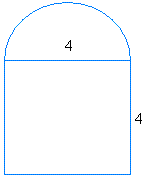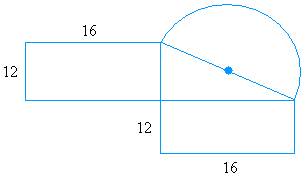Area of irregular shapes
To find the area of irregular shapes, the first thing to do is to divide the irregular shape into regular shapes that you can recognize such as
triangles, rectangles, circles, squares and so forth...Example #1:

Find the area for each of those two shapes and add the results
Square
Area of the square = s2
Area of the square = 42
Area of the square = 16
Circle
Area of the circle = pi × r2
Notice that the radius of the circle is 4/2 = 2
Area of the circle = 3.14 × 22
Area of the circle = 3.14 × 4
Area of the circle = 12.56
Since you only have half a circle, you have to multiply the result by 1/2
Area of the half circle = 1/2 × 12.56 = 6.28
Area of this shape = 16 + 6.28 = 22.28
Example #2:

Find the area for each of those three shapes and add the results
Triangle
Area of the triangle = (base × height)/2
Area of the triangle = (3 × 4)/2
Area of the triangle = 12/2
Area of the triangle = 6
Rectangle
Area of the rectangle = length × width
Area of the rectangle = 3 × 10
Area of the rectangle = 30
Trapezoid
Area of the trapezoid = ((b1 + b2) × h)/2
Area of the trapezoid = ((3 + 5) × 2)/2
Area of the trapezoid = (8) × 2/2
Area of the trapezoid = 16/2
Area of the trapezoid = 8
Area of this shape = 6 + 30 + 8 = 44
Example #3:
The area of irregular shapes can be as challenging as this last example, so study it carefully!

Find the area for each of those 4 shapes and add the results
Rectangle
Area of the rectangle = length × width
Area of the rectangle = (12 × 16)
Area of the rectangle = 192
Since we have two of the same rectangle, the area is 192 + 192 = 384
Triangle
Notice that the longest side of the rectangle is the base of the triangle and the short side of the rectangle is the height of the triangle
So,
Area of the triangle = (base × height)/2
Area of the triangle = (16 × 12)/2
Area of the triangle = (192)/2
Area of the triangle = 96
Circle
To get the area of the half circle, we need to know the diameter
Notice that the diameter is the hypotenuse of a right triangle, so use the Pythagorean Theorem to find the length of the diameter
c2 = a2 + b2
c2 = 122 + 162
c2 = 144 + 256
c2 = 400
c = √400
c = 20
Therefore, the diameter is 20. Since the diameter is 20, the radius is 10
Area of the circle = pi × r2
Area of the circle = 3.14 × 102
Area of the circle = 3.14 × 100
Area of the circle = 314
Since you only have half a circle, you have to multiply the result by 1/2
1/2 × 314 = 157
Area of this shape = 384 + 96 + 157 = 637
Here we go! I hope these good examples were very helpful in helping you how to get the area of irregular shapes.
Any questions on how to get the area of irregular shapes? Contact me.